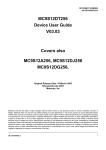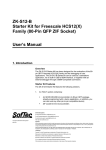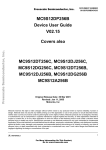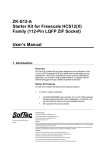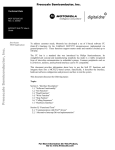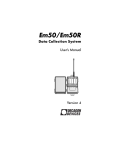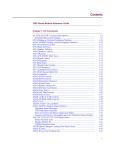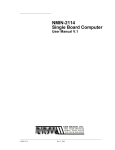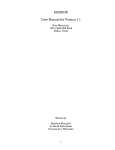Download NMIN-12A256B Single Board Computer
Transcript
NMIN-12A256B Single Board Computer User Manual V.1 NMIN-2114 Aug 18, 2003 Table of Contents 1.0 Overview . . . . . . . . . . . . . . . . . . . . . . . . . . . . . . . . . . . . . . . . . . . 1.1 Noted microcontroller features: . . . . . . . . . . . . . . . . . . . . . . . . 1.2 Included Files . . . . . . . . . . . . . . . . . . . . . . . . . . . . . . . . . . . . . 2 2 3 2.0 Getting Started . . . . . . . . . . . . . . . . . . . . . . . . . . . . . . . . . . . . . . 3 3.0 Memory Map . . . . . . . . . . . . . . . . . . . . . . . . . . . . . . . . . . . . . . . . 5 4.0 Programming the Board. . . . . . . . . . . . . . . . . . . . . . . . . . . . . . . 4.1 BDM Connector and Parallel Port . . . . . . . . . . . . . . . . . . . . . . 4.2 S-Records and the Serial Loader . . . . . . . . . . . . . . . . . . . . . . 4.2.1 Downloading S-Records . . . . . . . . . . . . . . . . . . . . . . . . . . . . . 4.3 On-board Development System . . . . . . . . . . . . . . . . . . . . . . . 4.3.1 Hooking Into Autoboot . . . . . . . . . . . . . . . . . . . . . . . . . . . . . . 4.3.2 Tags . . . . . . . . . . . . . . . . . . . . . . . . . . . . . . . . . . . . . . . . . . 4.3.3 Quick Entry . . . . . . . . . . . . . . . . . . . . . . . . . . . . . . . . . . . . . 4.3.4 Boot Entry . . . . . . . . . . . . . . . . . . . . . . . . . . . . . . . . . . . . . . 4.3.5 Auto Vector . . . . . . . . . . . . . . . . . . . . . . . . . . . . . . . . . . . . . 5 6 6 7 7 7 8 8 8 8 5.0 I/O Connections and Jumpers . . . . . . . . . . . . . . . . . . . . . . . . . . 8 6.0 Board Layout. . . . . . . . . . . . . . . . . . . . . . . . . . . . . . . . . . . . . . . . 10 7.0 Schematic . . . . . . . . . . . . . . . . . . . . . . . . . . . . . . . . . . . . . . . . . . 11 8.0 Examples . . . . . . . . . . . . . . . . . . . . . . . . . . . . . . . . . . . . . . . . . . . 8.1 Playing with the LEDs . . . . . . . . . . . . . . . . . . . . . . . . . . . . . . . 8.2 Reading from the A/D port . . . . . . . . . . . . . . . . . . . . . . . . . . . 8.3 Adding a Sensor . . . . . . . . . . . . . . . . . . . . . . . . . . . . . . . . . . . 8.4 Implementing an Interrupt . . . . . . . . . . . . . . . . . . . . . . . . . . . . 8.4.1 Real Time Interrupt Example . . . . . . . . . . . . . . . . . . . . . . . . . . 8.4.2 Interrupts Calling Forth . . . . . . . . . . . . . . . . . . . . . . . . . . . . . . 8.5 Flash Programming . . . . . . . . . . . . . . . . . . . . . . . . . . . . . . . . . 12 12 12 13 14 15 17 17 User Manual V.1 Aug 18, 2003 1 1.0 Overview The NMIN-12A256B single board computer provides you with plug and play access to a powerful microcontroller. The computer board provides power regulation, RS232 and RS422 serial support and an LCD connector. The microcontroller includes the following built in capabilities: I/O ports BDM A/D timers PWM Flash MC9S12A256 Microcontroller EEPROM RAM SPI interrupts SCI I2C Figure 1 Peripheral interfaces on the MC9S12A256 microcontroller. 1.1 Noted microcontroller features: • • • • • • • • • • • • • • • • • • • • • • 16-bit HCS12 CPU Multiplexed External Bus Interface for memory expansion Interrupt control for all onboard peripherals including priority manipulations Breakpoints for stepping through code without needing an emulator Single-wire BDM (Background Debug Mode) for downloading and debugging low current oscillator, PLL, COP watchdog, real time interrupt, clock monitor 8-bit and 4-bit ports with interrupt functionality Programmable rising or falling edge triggers 256K Flash EEPROM 4K byte EEPROM 12K byte RAM 8-channel 10-bit 5V Analog-to-Digital Converters 16-bit counter/timer with 8 programmable input capture or output compare channels Two 8-bit or one 16-bit pulse accumulators 8 PWM channels Two asynchronous Serial Communications Interfaces (SCI) up to 115K baud Three Synchronous Serial Peripheral Interface (SPI) Inter-IC Bus (IIC) compatible with I2C Bus standard I/O lines with 5V input and drive capability Operation at up to 50MHz for core and up to 25MHz bus speed for peripherals Single-Chip and Expanded Modes Low power modes User Manual V.1 Aug 18, 2003 2 The computer board’s power consumption is about 60 mA. 1.2 Included Files The following files are included and are available from our website. The MaxForth files are only available if you have licensed them: • • • • • • • • • • • • • • as12 - Mac OS X version of the Motorola freeware assembler as12.exe - PC version of the Motorola freeware assembler as12.htm - documentation for the assembler BootEVB-16.S19 - Serial Boot loader, srecord file DB12DP256-16.S19 - Dbug12 monitor, srecord file HCS12Manuals.zip - contains a copy of the Motorola manuals for the microcontroller from their website. Note: these are too big to put on a Floppy so they are available at: http://www.ee.ualberta.ca/~rchapman/MFwebsite/HCS12/HCS12Manuals.zip NMIN-12A256Bv1.pdf - this manual in PDF format Out.S19 - output of converted srecord rtiled.lst - output of assembled source code rtiled.s - source code example of an interrupt and power saving instruction WAI rtiled.s19 - srecord output from assembler SRecCvt (OSX) - srecord conversion utility for Mac OS X SRecCvt.exe - srecord conversion utility for PCs SRecCvtRG.pdf - srecord conversion utility documentation Licensed files: • fuzzytest.f - an example file for testing the fuzzy logic support • mf51fhcs12.map - contains a map of all the bits and pieces in MaxForth for the current release but may change in future releases. Use with caution. • MF51FHCS12.S19 - a copy of the MaxForth kernel in Motorola S-record form that can be downloaded when experimenting with flash • SCRUB.F - a utility for clearing vectors from EEPROM and flash • SHT11.F - an example of interfacing to a temperature and humidity sensor • TESTA24.F - an example to test ATO4 NOTE: Throughout the manual, 0x is used to precede hex addresses in the text for clarity but it is not used in the MaxForth examples because the numeric base is changed by typing HEX or DECIMAL. 2.0 Getting Started Computer Board MMC211421142114 (Sika) Flash Programmer : Power Serial Cable Figure 2 Computer hooked up to board with a serial cable. You will interact with your board by connecting it to a PC using a serial cable and running a terminal program such as HyperTerminal or an equivalent setup. You need to set it to 9600 BAUD, one stop bit, no parity and 8 User Manual V.1 Aug 18, 2003 3 data bits. Connect an RS232 serial cable between your PC’s COM port and the serial port on the board. To power up the board, you need a 7 to 12 volt plug-in transformer plugged into the power jack, PJ1 (AC, DC both polarities accepted). Alternatively, you could use Linux or a Mac. On the Mac, ZTerm is a powerful terminal program available as shareware from the Internet. When everything is ready and you plug in the power, you should receive a prompt in the terminal program. If you have the J4 jumpers set to the serial loader position: D-Bug12 Bootloader v1.0.0 a) Erase Flash b) Program Flash c) Set Baud Rate d) Erase EEPROM ? or if the J4 jumpers are set to the application position and the D-Bug12 monitor application is loaded: D-Bug12 4.0.0b18 Copyright 1996 - 2002 Motorola Semiconductor For Commands type "Help" > or if the J4 jumpers are set to the application position and MaxForth is loaded: Max-FORTH V5.1F (license agreement is required) And when you depress the ENTER key, it should respond with type ? for help : or > or OK (Max-FORTH prompt) When you see that message, it means the communication is established and you are ready to interact with the board and microcontroller. By pressing the reset button, RS1, you should get the same boot prompt as when you powered it up. Pressing the reset button will leave the contents of most of the RAM intact which might be useful for debugging purposes, whereas, if you power cycle the board, then all RAM contents will be lost. User Manual V.1 Aug 18, 2003 4 3.0 Memory Map The memory map consists of RAM, ROM and registers. The interrupt vectors exist in protected flash space along with the serial loader. Since they can’t be changed, a secondary vector table exists at 0xEF80. There is a one to one correspondence with the primary vector table. Since these locations can only be written once, the entire 512 bytes must be erased to change a vector. For prototyping, the vector can be set once to point into EEPROM which can be erased more easily. When only the serial loader is loaded, it relocates RAM to the top of memory and copies itself to it to run only out of RAM. This allows the changing of page F through the flash window at 0x8000. The MaxForth system takes up space in page E and page F of flash leaving pages 0 to page D available for use. None of the EEPROM is used so it is all available for use for user applications. Serial Loader 0xFFFF RAM MaxForth 0xFFFF 0xD000 Flash Page F Flash Page F 0xC000 primary vectors 0xFF80 serial loader secondary vectors 0xF000 0xEF80 system 0xC000 Flash window pages 0-F 0x8000 Flash window pages 0-D free space 0x8000 system Flash page E 0x4000 Flash page E 0x4000 RAM 0x1000 0x1000 EEPROM 0x0400 0x0000 registers EEPROM 0x0400 0x0000 free space system free space registers Figure 3 After booting, the RAM memory map either belongs to the serial loader or the MaxForth application. 4.0 Programming the Board When the board is reset, it executes the program pointed to by the vector at location 0xFFFE. In a loaded board this will be the boot loader which will either start the serial loader or MaxForth. When MaxForth starts, it checks to see if there is an autostart application present and runs it or else it just runs MaxForth. There are several ways in which to program the board: 1. User Manual V.1 download an s-record through the BDM connector and the PC parallel port using a programmer Aug 18, 2003 5 2. 3. such as P&E Micro’s BDM programmer. download s-records using the embedded serial loader and a serial port with HyperTerminal, NMITerm or equivalent interact directly with the microcontroller and download source code to the on-board development system, MaxForth, through a serial port and HyperTerminal When downloading text files to the board, using the text download protocol, make sure the delay per line is at least 100 milliseconds. You can risk having lines missed if you go to fast, but with some setups, it is possible to use smaller line delays which has a nice effect on a long download. Your mileage will vary. 4.1 BDM Connector and Parallel Port Using the HCS12 cable from P&E Micro or equivalent, plug it into the parallel port of your computer through a parallel port cable and the BDM port on the computer board making sure to orientate the triangle on the pin header to pin 1 on the board which is marked by a square solder pad on the bottom of the board. Apply power to the board. When disconnecting from the board make sure it goes through a power cycle before you try out the downloaded software since a reset is not enough to regain control of the microcontroller after interacting with the BDM port. Check the help screens for more details. 4.2 S-Records and the Serial Loader Using the serial loader, you can download s-records that have been created by a C compiler or Assembler program that you have acquired separately, to flash memory to be run. The help menu, invoked by typing a ?, is: ? ? a) Erase Flash b) Program Flash c) Set Baud Rate d) Erase EEPROM ? The serial loader works by running out of RAM. At bootup, the boot program in flash checks to see if there is an application by checking for a vector at 0xEFFE. If there isn’t, then it copies the serial loader program from flash to RAM and then runs the program. The serial loader program must run out of RAM to be able to program flash memory. If you download an application, reboot and nothing happens, you can recover to the serial loader by setting the jumpers on the J4 connector with a jumper or equivalent and pressing the reset button. You will be taken back to the serial loader where you can erase your errant application and try again. Figure 4 Jumper positions on the J4 connector for booting into the serial loader or an application. If there are no jumpers, then the default will be the Application. This is important if you intend to use channel 0 and 1 of the A/D input since leaving jumpers in the Application position will prevent those inputs from being used. User Manual V.1 Aug 18, 2003 6 4.2.1 Downloading S-Records The serial loader uses a simple text transfer protocol to transfer data from the host computer to the board. Depending on your host program and its defaults, the setting may be not right. Try it first and if it doesn’t work, modify some of the settings. To install a fresh copy of MaxForth and erase all the flash, do the following: 1. get to the serial loader from Forth by FLASH or by resetting with the J4 connector set like in Figure 4. 2. press a 3. wait till done, then press b 4. download the MaxForth s-record with the text protocol, by cutting and pasting or dragging and dropping if supported 5. wait till done, then press reset with the J4 jumpers removed or in the Application position Quick Tip !! For an extremely fast download, you could try setting the baud rate to 115200, set line delay to zero and flow control to X-ON/X-OFF. Using this setup, you can download the entire kernel in seconds when needed. You could also use this method to download s-records to flash for code to be autostarted or run from MaxForth. 4.3 On-board Development System Taking advantage of the interactive nature of the board’s development system, MaxForth, you can interact directly with the microcontroller’s peripherals by fetching and storing values to the memory mapped configuration registers for the peripheral devices. This is an effective way of understanding the peripheral documentation, verifying correct initialization sequences, running some tests on different configurations and debugging driver code as you develop it. By typing in new definitions, you can add new macros to the dictionary for interactive use or for creating an automated program. Some examples are given later on. 4.3.1 Hooking Into Autoboot You can autoboot an application by leaving a vector to it at location 0xEFFE. The startup boot loader will detect this vector and then jump to the location that the vector is pointing to. When MaxForth is installed, it has a vector at that location. To get to the serial loader from MaxForth, type in FLASH and hit enter. To get back to the serial loader from an application, jump to location 0xF02E in memory. The application area can be erased using the serial loader without the boot loader being removed from memory. MaxForth occupies the space from 0x4000-0x7FFF and 0xC000-0xC911. At location 0xEFFE is the start vector for MaxForth which is what the bootloader looks for when booting. MaxForth can be replaced by erasing it and writing a new application in its place, making sure that the startup vector for the new application is at 0xEFFE. If you want to hook into the MaxForth autoboot system, then there are several places where you can do this: • quick entry - allow setting of COP and other write-once registers on the micro. • boot entry - MaxForth has been setup and can be augmented • auto vector - last possible chance before Forth is started up User Manual V.1 Aug 18, 2003 7 Table 1: Noted Memory Locations for Startup Hooks Name Value Notes quick_tag 0x0FEC store a tag1 quick_vector 0x0FE8 CFA of word to call boot_tag 0x0FE0 store a tag2 boot_vector 0x0FE4 CFA of word to call boot_start 0x0400 lower limit in flash for checking for an auto vector tag2 on a 1K boundary boot_end 0xF000 upper limit of flash for auto vector tag2 checking 1. A55A 2. A44A for first autostart or A55A for continuous last autostart. 4.3.2 Tags The patterns 0xA44A and 0xA55A are referred to as tags and are used during the autoboot process to find vectors to be executed during the bootup process. Only the lowest A44A and A55A tag will be executed with A44A going first. This applies to the boot entry and autovectors. The quick entry, if used, only uses A55A. 4.3.3 Quick Entry Quick entry lets you get in on the boot process and set COP or any other write once registers before MaxForth starts up. The tag contains a bit value that is checked first and if present, then the CFA stored at the vector preceding it is executed. HEX A55A FEC EE! ' COP-RUN CFA FE8 EE! ( hook into quick entry vector ) 4.3.4 Boot Entry Boot entry lets you take over or execute something after MaxForth has been initialized. This is a good time to modify the dictionary linkage to add extra words from flash. The vector follows the tag. HEX A44A FE0 EE! ' STARTUP CFA FE4 EE! ( hook into boot-start vector ) 4.3.5 Auto Vector As well, at any 1K boundary in RAM, EEPROM or flash you can lay down a tag followed by a vector. HEX 1000 AUTOSTART STARTUP ( hook into auto-start vector ) 5.0 I/O Connections and Jumpers The jumpers and I/O headers from the board are as follows: • • • • • • • J1 is the primary serial port, SC0, that is used for the serial bootloader, dbug12 monitor and MaxForth J2 is the second serial port, SCI1. J3 is the jumper for LCD contrast. J4 is for selecting boot to Serial Loader or application such as MaxForth J5 is the analog input header J6 is the I/O and other peripheral interface signals J7 is the jumpers for future memory expansion User Manual V.1 Aug 18, 2003 8 • • • • J8 is the LCD connector, or SPI, or Timers shared I/Os J9 is the BDM OUT that supports motorola DBUG12 POD mode. J10 is the BDM in interface. DB2 has the same pinout as J6 for Dsub 44 pin. The connector is not installed. Additionally: • • • • the red LED is controlled by port M bit0, PM0 the green LED is controlled by port M bit1, PM1 Resistor POT, R4 provides the voltage to the LCD that is used to adjust the LCD contrast RS1, reset switch User Manual V.1 Aug 18, 2003 9 6.0 Board Layout PJ1 DB1 (0,3.225) J1 (2.400,3.225) (2.250, 3.000) 1 C1 CACB (2.300,2.825) (0.100,2.225) C3 R7 C4 R13 R9 C10 R5 C18 HC05 VR1 LM2937 C9 C12 C11 U2 XTAL1 Y1 LD2 R6 U3 CR1 C6 C8 C13 C14 C15 LD1 R12 (0.100,1.800) J3 MAX232N C2 R8 RP1 C7 J9 J8 J2 9 C5 J10 6 D1 (0.100,2.600) BKGD (0.150,2.800) R10 R11 RS1 C16 (2.300,1.625) R4 J4 C17 R2 R3 J5 R1 C19 (0.150,0.900) L2 J7 L1 (2.250,0.900) U1 BCN01 J6 (2.300, 0.600) DB2 WWW.NEWMICROS.COM (0.275,0.225) (2125,0.225) (2400,0) (0,0) User Manual V.1 Aug 18, 2003 10 D C B A CA 8 J1 1 1 2 3 4 5 5 6 9 SCI0 J2 6 7 8 9 3 8 6 4 2 5 10 1 7 J10 9 SCI1 1 BDM IN J9 BDM OUT C2 1uF 12 +5V HC05 13 47K +5V R11 1 0.1uF 4.7K R10 BKGD 10K +5V R9 PT7 0.1uF CB 8 VRH 7 2 4 6 U2 1 C3 5 PAD03 PAD01 R8 C4 1uF RESET 10K +5V 1uF 3 RxD0 C1 10 9 1uF 8 7 RxD1 TxD1 TxD0 SI0 SO0 12 11 4 PAD05 VRL 13 14 6 PAD07 10K PAD01 LVI1 1 3 S80840 RS1 R6 SI1 SO1 3 8 2 MAX232CWE J5 PAD00 5 10 1 PAD02 7 2 R4 +5V 9 A/D +5V J4 PAD04 10 PAD06 10K +5V R5 PT6 1N4148 D1 PAD00 +5V R1 10K HC05 11 7 6 C18 PJ1 2.2K 6 R4 +5V J3 10K J7 VRH 0.1 VRL C17 0.1 L2 10uH R2 R3 CR1 10K 10K VM08 +5V R7 4.7K L1 C11 Y1 22PF 16Mhz 5 22PF C13 .047 C10 10uH .0047 C12 71 72 73 63 64 65 66 46 76 75 71 70 16 15 14 15 30 25 26 32 31 77 29 59 60 61 62 49 9 36 28 33 10 50 76 34 35 PM4 PM3 PM2 PS0/RXD0 PS1/TXD0 PS2/RXD1 PS3/TXD1 PAD00 PAD01 PAD02 PAD03 PAD04 PAD05 PAD06 PAD07 BKGD RESET PE6 PE5 XFC GND PT0 PT1 PT2 PT3 PT4 PT5 PT6 PT7 VREGEN PM1 PM0 PJ6 PJ7 PA0 PA1 PA2 PA3 PA4 PA5 PA6 PA7 PB0 PB1 PB2 PB3 PB4 PB5 PB6 PB7 PE0 PE1 PE2 PE3 PE4 PE7 PM5 PP0 PP1 PP2 PP3 PP4 PP5 PP7 C9 U1 VDDPLL VDDX VDDR VDDA VRH VRL VSSA VDD2 VDD1 TEST VSSR VSSPLL VSS1 VSS2 VSSX EXTAL XTAL C6 0.1uF OUT VR1 LM2937 C7 0.1uF IN 100uF 5 MC9S12A256B 5 6 7 8 11 12 13 14 67 74 75 69 68 41 42 43 44 45 46 47 48 16 17 18 19 20 21 22 23 40 39 38 37 27 24 70 4 3 2 1 80 79 78 +5V +5V C8 4 100uF 4 +5V C19 VSS J8 3 +5V PT1/D1 PM2/RS/MISO0 PT3/D3 Vo PT5/D5 PM4/E1/MOSI0 PT0/D0 PM3/RW/SS0 PT4/D4 PT2/D2 DB2 SHARED IO/LCD/SPI 1 2 3 4 5 6 7 8 9 10 11 12 13 14 15 VDDPLL C14 VSSPLL C5 +5V PM5/E2/SCK0 PT7/D7 NC PT6/D6 PJ7 PJ6 PS3 PS2 PS1 PS0 PA7 PA6 PA5 PA4 PA3 PA2 PA1 PA0 VSS C15 +5V BYPASS CAPACITORS VDDA C16 VSSA 3 31 17 32 18 33 19 34 20 35 21 36 22 37 23 38 24 39 25 40 26 41 27 42 28 43 29 44 30 16 PB7 PE6 PB6 PE5 PB5 PE4 PB4 PE3 PB3 PE2 PB2 PE1 PB1 PE0 PB0 PP7 PM5 PP5 PM4 PP4 PM3 PP3 PM2 PP2 PM1 PP1 PM0 PP0 PE7 PM0 3 1 APPROVALS T.V.N C.N. 2 2 4 2 HC05 5 HC05 PM1 DRAWN CHECKED FINISH PP0 PP2 PP4 GND PA0 PA2 PA4 PA6 PS0 PS2 PM0 PM2 PM4 PJ6 PE0 PE2 PE4 PE6 PB0 PB2 PB4 PB6 +5V 6 DATE 051303 052103 J6 TITLE LD2 LD1 46 44 42 40 38 36 34 32 30 28 26 24 22 20 18 16 14 12 10 8 6 4 2 SIZE D SCALE 300 R12 +5V R13 PP1 PP3 PP5 PP7 PA1 PA3 PA5 PA7 PS1 PS3 PM1 PM3 PM5 PJ7 PE1 PE3 PE5 PE7 PB1 PB3 PB5 PB7 8 300 45 43 41 39 37 35 33 31 29 27 25 23 21 19 17 15 13 11 9 7 5 3 1 HC05 9 NMIN-12A256B DRWG # BCN01 1 SHEET 1 REV 02 D C B A 8.0 Examples These examples may be typed in interactively or cut and pasted into the terminal window if you are using MaxForth. Alternatively, they can be translated to the language that you are using to program the microcontroller with. 8.1 Playing with the LEDs There is a green and red LED attached to port M bits 1 and 0 respectively. You can easily turn these on and off from MaxForth using the following code. Note that constants are defined for the registers for convenience: HEX 250 CONSTANT PTM 252 CONSTANT DDRM 1 DDRM C! 1 PTM C! 2 DDRM C! 2 PTM C! 3 DDRM C! 3 PTM C! ( ( ( ( ( ( ( ( define port M address define data direction register for port m set bit 0 as an output and all others as inputs turn on the red led connected to bit 0 set bit 1 as an output and all others as inputs turn on the green led connected to bit 1 set bits 0 and 1 as outputs; all others as inputs turn on both leds 8.2 Reading from the A/D port For this example we will consider the simplest way to get an A/D reading: get A/D reading initialize A/D request channel 0 channel 0? not yet display reading Done. This involves: setting up the A/D registers so it is ready to go; requesting a read of a channel; waiting for that channel to complete converting; and finally, reading and displaying the value. Each of these boxes on the diagram will become a word except for Done. HEX ( A/D peripheral registers 82 CONSTANT ATD0CTL2 83 CONSTANT ATD0CTL3 User Manual V.1 Aug 18, 2003 12 84 85 86 90 CONSTANT CONSTANT CONSTANT CONSTANT ATD0CTL4 ATD0CTL5 ATD0STAT ATD0DR0 : INIT-A/D ( -- ) 7 ATD0CTL4 C! ( 10 bit resolution; prescaler greater than 6 40 ATD0CTL3 C! ( 8 conversions per sequence C0 ATD0CTL2 C! ; ( power up, fast flag clear and interrupts off : REQUEST0 ( -- ) 80 ATD0CTL5 C! ; ( 8 conversions, right unsigned, one-shot, channel 0 : CHANNEL0? ( -- f ) ATD0STAT C@ 80 AND ; : DISPLAY-READING ( -- ) : GETAD REQUEST0 INIT-A/D ATD0DR0 @ . ; BEGIN CHANNEL0? UNTIL DISPLAY-READING ; 8.3 Adding a Sensor The SHT11 from Sensirion is a smart sensor combining temperature and relative humidity sensors with an onboard conversion and a two wire communication facility all in a very tiny package. In the following example it is hooked up to PORT T of the microprocessor. One line is used to provide clock and the other line is used as a bidirectional line for communication. ( SHT11 interface for MaxForth ( ( ( ( ( ( Rob Chapman Aug 13, 03 The SHT11 sensor chip provides 14 bit resolution on temperature and 12 bit resolution on relative humidity. The four pins connect to +5, GND, PT1 for clock and PT3 for data. PT1 is the serial clock; PT3 is the data line and is bidirectional so care must be taken not to drive it high, just low so there will be no conflicts. It can be driven low but is pulled high by pull up resistor. HEX ( Registers 242 CONSTANT DDRT 240 CONSTANT PTT 244 CONSTANT PERT ( data direction register for port T ( port t outputs ( port t enable for pull ups ( Debugging : PT7TRIG ( pulse pt7 low for debugging with scope DDRT C@ 80 OR DUP DDRT C! ( enable PT5 output PTT C@ AND 7F AND DUP PTT C! ( set it low 80 OR PTT C! ; ( set it high ( : : : : : Clocks K1 2 PTT C@ OR PTT C! ; K0 2 NOT PTT C@ AND PTT C! ; K01 K0 K1 ; K10 K1 K0 ; K10S 0 DO K10 LOOP ; ( Data User Manual V.1 Aug 18, 2003 13 : D0 A DDRT C! PTT C@ 8 NOT AND PTT C! ; : D1 2 DDRT C! ; ( Protocol: 8 bit command and 16 bit data : SHT-CMD ( n -- ) D1 K0 9 K10S K1 D0 K01 D1 K0 D0 3 K10S 10 5 0 DO K0 2DUP AND IF D1 ELSE D0 THEN K1 2/ LOOP 2DROP D1 K01 K0 ; : DAT-READY? ( -- f ) PTT C@ 8 AND 0= ; : GET-8 ( n -- n' ) 8 0 DO K0 2* PTT C@ 8 AND IF 1 OR THEN K1 LOOP ; : GET-DAT ( -- n ) 0 GET-8 K0 D0 K10 D1 GET-8 K01 K0 ; ( Exchanges : RST 1E SHT-CMD ; ( Initial setup : INIT-SHT 2 PLACES ( for printout format 2 DDRT C! ( clock is output always FF PERT C! ; ( pull up enabled DECIMAL ( Tests for temperature in Celsius and relative humidity (RH) ( Values obtained from chip are in a raw format and need to be massaged ( Formula for temperature: -40 + .01*rawTE ( Formula for linear RH: -4 + rawRH*(.0405 + -2.8*10-6 * rawRH ) ( Formula for true RH: linRH + (TE-25)( .01 + .00008*rawRH) : TEMP 3 SHT-CMD BEGIN DAT-READY? UNTIL S>F .01E F* 40E F- F. ; GET-DAT : RELH 5 SHT-CMD BEGIN DAT-READY? UNTIL GET-DAT S>F FDUP -2.8E-6 F* .0405E F+ FOVER F* 4E F- ( linear RH FSWAP ( linear rh \ raw rh 3 SHT-CMD BEGIN DAT-READY? UNTIL GET-DAT S>F .01E F* 40E F- ( temperature for compensation ( linear rh \ raw rh \ temp 25E F- FSWAP .00008E F* .01E F+ F* F+ ( RH true ) F. ; To get results from the sensor chip you must first initialize the port and then get data. For example if we get data and then breath on the chip to increase humidity and humidity we can get the following results: INIT-SHT OK TEMP 26.36C RELH 43.94% ( breathe on TEMP 27.75C RELH 80.76% OK OK sensors for 5 seconds OK OK 8.4 Implementing an Interrupt The HCS12 contains a lot of parts to get right (usually all of them) before you can make an interrupt (more generally referred to as an exception) happen. You must set up the CPU, the interrupt controller and an interrupt source such as a peripheral. Setting up the CPU involves modifying CPU control register while setting up the interrupt controller and peripheral involves modifying their memory mapped control registers. User Manual V.1 Aug 18, 2003 14 The interrupt machinery on the HCS12 supports a wide range of operational capabilities. You can just use one interrupt or support a complex system of prioritized interrupts from all peripherals. Interrupts can even be forced to happen to provide for a way of testing or syncing. To set up an interrupt you'd f ollow these steps: 1. 2. 3. 4. write an interrupt service routine which will turn off the source of the interrupt when invoked by the interrupt. This routine must end with the assembly instruction rti. put the address of this routine in the right location in the secondary vector table enable the peripheral enable interrupts 8.4.1 Real Time Interrupt Example The real time interrupt is a simple interrupt to enable and service so it is a good one to start with. This following example is written in assembler and be compiled on a computer and downloaded with the serial loader: ; ; ; ; RTI interrupt vector Rob Chapman Jun 20, 2003 startup sets up port M and initializes the real time interrupt (RTI), turns on the green LED and then does nothing the RTI just changes the red LED every 64ms ; Registers Used CRGFLG equ $37 RTICTL equ $3B CRGINT equ $38 DDRM equ $252 PTM equ $250 ; Startup code org $C000 startup: lds #$4000 movb #$03,DDRM movb #$02,PTM movb #$7F,RTICTL movb #$80,CRGINT cli lowpower: wai bra lowpower ; Service interrupt routine sir_rti: movb #$80,CRGFLG ldaa PTM eora #01 staa PTM rti ; ; ; ; ; RTI interrupt flag RTI control register RTI interrupt control port M data direction register port M outputs: 0 is red, 1 is green ; ; ; ; ; ; establish a stack drive port M bits 0 and 1 turn off red LED and turn on green LED 64ms timer enable RTI interrupts enable interrupts ; go to low power mode ; save energy for real time interrupt ; reset RTI interrupt ; toggle red LED ; return from interrupt ; secondary vector table additions ; rti tie in org $EFF0 ; RTI vector dw sir_rti ; startup tie in User Manual V.1 Aug 18, 2003 15 org $EFFE dw startup ; application vector To compile this program, you can use the freeware assembler as12 on a PC or a Mac. The assemblers are with the included files. Once the program is compiled, you must then convert the output srecord with another freeware program sreccvt. This gets it into the right download format. Then you download the file and once it is done, press the reset button. You should see the green LED light and the red LED flash rapidly. NOTE: If you are using the D-Bug12 monitor application, then you will not have to convert the s-record format but you should org to a different address. On a PC you can assemble and convert from a DOS command prompt and then download with a terminal program. You can either put the as12 and sreccvt programs right in your working directory or put them elsewhere and then add the path to your autoexec.bat file. Once you’ve established the proper sequence, you can automate it by putting it into a batch file. On a Mac using OS X, you assemble and convert using a unix terminal window. You can either keep the programs local or put them into a common directory. For instance you could do the following: sudo cp as12 /usr/bin/ Password: rehash This puts the as12 program into your /usr/bin directory so that you can call it from anywhere. The same procedure can be done for sreccvt. The rehash command just makes the new command available right away. To assemble the program: as12 rtiled.s > rtiled.lst This will produce two outputs. The .lst file is a listing of the assembled program while the .s19 file is the output srecord. The srecord file must then be converted to the correct format for downloading: sreccvt -m 00000 fffff 32 -lp rtiled.s19 SRecCvt v1.0.11 Converting S-Record File: rtiled.s19 S-Record File Conversion Complete If you want to see the output, you can view it from the command line: more Out.S19 S2240FC000CF4000180B030252180B020250180B7F003B180B80003810EF3E20FD180B800057 S2240FC02037B6025088017A02500BFFFFFFFFFFFFFFFFFFFFFFFFFFFFFFFFFFFFFFFFFFFF63 S2240FEFE0FFFFFFFFFFFFFFFFFFFFFFFFFFFFFFFFC01CFFFFFFFFFFFFFFFFFFFFFFFFC0007D S9030000FC Download the program by first selecting a to erase the flash and then b followed by the above srecord: D-Bug12 Bootloader v1.0.0 a) b) c) d) Erase Flash Program Flash Set Baud Rate Erase EEPROM User Manual V.1 Aug 18, 2003 16 ? a a) Erase Flash b) Program Flash c) Set Baud Rate d) Erase EEPROM ? b *** Reset the board. If all goes well, the green LED should be on and the red LED should be blinking. Make sure you change the J4 jumpers for the application to run. 8.4.2 Interrupts Calling Forth As for calling a Forth word from an interrupt, this is doomed to fail at some point since not all Forth words including the virtual machine are interruptible without some extra context savings. This all adds overhead and goes against keeping interrupts as short as possible. If you keep your interrupts simple and in assembler, then they have a greater chance of working and meeting system time constraints. 8.5 Flash Programming There is 256K of flash memory available on chip but since the microcontroller has only 16 bits of address space, or 64K, you must access the flash through a programming window. Flash memory may only be written when it is in the region 0x8000-0xBFFF which is referred to as the program memory page window. This region is a 16K window which can be used to access all of the 256K of flash memory. To change which 16K region of memory is accessed there, you need only change the PPAGE (0x30) register. Since there is only 256K of flash but the register is 8 bits, the memory windows will be unique for a small range only and then wrap after that. For example, putting 0 into PPAGE (HEX 0 30 C!) will access the lowest 16K of the 256K flash memory, but so will 16, 32, 48, etc. To access the top page of flash, which also appears in the memory map from 0xC000 to 0xFFFF, you would store 15, 31, 47, etc. into the PPAGE register (HEX F 30 C!). These sections of flash are referred to as pages of flash. As noted in the memory map (Figure 3 on page 5), page E and page F are permanently in the CPU memory map but they can also be accessed through the programming page window. For instance if you store 14 into the PPAGE register, you will see the same memory image at location 0x4000 as you will see at 0x8000. If you want to install interrupt vectors in the secondary vector table at 0xEF800xEFFF, then you must put page F into the programming window. For instance if you want to install an interrupt vector for the real time interrupt (RTI) which is at 0xEFF0, you'd do the f ollowing: HEX F 30 C! address_of_interrupt_vector AFF0 FL! Note that 0xAFF0 is 0x4000 less than where the actual interrupt vector is to be but that it will appear there. If you try to use FL! in any other memory area outside of the programming window, it will not work. As described in the microcontroller manual on flash memory, the upper 16 bytes of EEPROM are reserved as control registers for the EEPROM. You should avoid setting values in this range (0xFF00xFFF) unless you know what you are doing. Setting the wrong values in this region has the potential to lock out use of the EEPROM from being erased. The EEPROM differs from the flash memory in two other aspects. Its erase size is 4 bytes while the flash is 512 bytes. This makes the EEPROM easier to reprogram in small amounts. In MaxForth you can program a byte location irregardless of its value as it will be erased first by EEC! if necessary. In flash memory, the minimum programming size is an aligned 2 bytes and the location must be 0xFFFF to begin with. To program EEPROM use EEC!, EE!, EEMOVE and EEWORD. To program flash, use FL!, FLMOVE, FLERASE and FLWORD. EDP is used by EEWORD and FDP is used by FLWORD. User Manual V.1 Aug 18, 2003 17


















